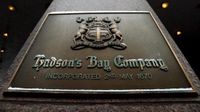TORONTO — As Hudson’s Bay prepares to liquidate nearly its entire retail empire, the future of its vast real estate portfolio has raised questions about the potential interest of two of Canada’s remaining department store giants: La Maison Simons and Holt Renfrew. However, both retailers appear to be taking a cautious approach, showing little inclination to absorb the Bay’s extensive footprint.
On April 10, 2025, reports surfaced indicating that neither Holt Renfrew nor Simons plans to pursue the leases of the Bay’s stores, which include 74 locations, 13 Saks Off Fifth outlets, and two Saks Fifth Avenue sites. Holt Renfrew spokesperson Adam Grachnik confirmed that the luxury retailer is “not considering” making a play for these leases but is committed to assisting colleagues in exploring any opportunities that may arise.
Meanwhile, La Maison Simons CEO Bernard Leblanc echoed this sentiment, stating that his company has “no new announcements planned.” He emphasized that while Simons is always ready for a challenge, it is carefully analyzing all potential opportunities across Canadian markets. “We are not rushing things,” he noted, adding that the company’s goal is not to be the biggest retailer but to be the best in the eyes of its customers.
Retail experts suggest this cautious stance is wise, especially as the retail landscape shifts. J.C. Williams Group retail strategist Lisa Hutcheson remarked that retailers are becoming increasingly mindful of balancing the need for a physical presence with the risks of overextending their real estate holdings. If either Simons or Holt Renfrew were her clients, Hutcheson would advise against pursuing the Bay’s extensive locations.
Instead, she hinted that taking over one or two of Hudson’s Bay’s prime locations could be a consideration “down the road.” The reasoning behind this is that some of these sites are situated in desirable shopping districts and may be more affordable to obtain due to the Bay’s current creditor protection status. However, she cautioned that Canada has a limited population to support such large retail footprints, making this a costly endeavor even for established players like Simons and Holt Renfrew.
“There’s still a cost to build these stores out,” Hutcheson explained. “Millions goes into them, and it’s not just the rent, but the commitment to fill the store with inventory and staff.”
Simons is not entirely passive in its growth strategy. The retailer has plans to open new locations in Yorkdale and Eaton Centre malls in Toronto by this winter, just doors away from two of the last remaining Bay stores. This expansion is part of a $75 million investment and will bring Simons’ total store count to 19. Leblanc has previously stated that the company’s approach is deliberate, reflecting a preference for slow and steady growth rather than rapid expansion.
“It’s a long play for us,” he told The Canadian Press last spring. “We have been and will continue to be patient because the intent is not to be the biggest. It’s really to be the best at what we do.”
Holt Renfrew, which traces its origins back to 1837 as a fur shop in Quebec, shares a similar philosophy. The luxury retailer, known for its high-end designer offerings, currently operates just six stores across Canada. Lanita Layton, a luxury and retail consultant who once served as a vice-president at Holt Renfrew, noted that the company has long adhered to a strategy of not overextending itself.
“They decided many, many years ago that they’re not going to bite off more than they can chew,” Layton said. This approach allows the retailer to maintain high standards of customer service and profitability, given the premium inventory it carries. She believes that many of Hudson’s Bay’s locations will not appeal to Holt Renfrew, primarily because they are situated in areas that do not attract the luxury shoppers the brand targets.
Even Simons may find some of the Bay properties too expansive, according to Layton. “I would imagine each of them is hopefully going to take advantage of what’s happening with the Bay and maybe expanding a little on their home and epicure, but it’s not going to need 100,000 square feet,” she suggested.
As Hudson’s Bay’s liquidation unfolds, the retail landscape in Canada is poised for significant change. With both Simons and Holt Renfrew taking a measured approach to expansion, the future of department store shopping in Canada remains uncertain. The ongoing shift in consumer preferences towards online shopping and the need for brick-and-mortar stores to adapt to new realities further complicate the situation.
Retailers are increasingly aware of the importance of creating unique in-store experiences that cannot be replicated online. As such, the focus is shifting from merely having a physical presence to ensuring that each location serves a specific purpose and meets the needs of the customer base.
In light of these developments, the retail sector will continue to evolve, and it will be interesting to see how Simons and Holt Renfrew navigate the opportunities and challenges that lie ahead. While Hudson’s Bay’s liquidation marks the end of an era for one of Canada’s oldest retailers, it also opens the door for new possibilities within the industry.
This report by The Canadian Press was first published on April 10, 2025.





